
Before starting out Triangle Strategy review, let’s go back in time – it’s 1998 and you’ve just put Final Fantasy Tactics or Tactics Ogre into your PlayStation. The tactics RPG just made its way to the west and you’re wondering if we’ll ever get another game like it.
Or maybe it’s 2003 and your first foray into the genre is Disgaea: Hour of Darkness and you wonder if the genre has potential for more serious storytelling. But now it’s 2022, the tactics RPG genre has been dominated by Fire Emblem (with a few Disgaea releases too), and now Square Enix has come back with Triangle Strategy. Does Triangle Strategy live up to the high bar set by Final Fantasy Tactics? Does it even try to? Maybe it’s unfair to compare the two, but it’s impossible not to – read on in our Triangle Strategy review!
Triangle Strategy
Developer: Artdink
Publisher: Square Enix
Platform: Nintendo Switch (Reviewed)
Release Date: March 4, 2022
Players: 1
MSRP: $59.99

I say Square Enix came back to the genre, but more accurately it’s Artdink at the helm of development. Artdink is largely known for their series of railroad business simulators called A-Train so they may seem like an odd choice to helm Triangle Strategy.
However, it was Artdink that published Tactics Ogre on the PlayStation so they’ve at least touched the genre. But despite this, Square’s fingerprints are all over this game and can be felt in the aesthetic choices made in its design.
Players take on the role of Serenoa Wolffort, heir to the Wolffort family which exists as one of the three “high houses” of Glenbrook. Glenbrook, is one of three nations in the land of Norzelia, a seemingly landlocked territory. The other two countries are Aesfrost, a mountainous realm to the north which sits on vast deposits of iron, and the holy land of Hyzante which harvest’s the region’s salt from its massive salt lake.
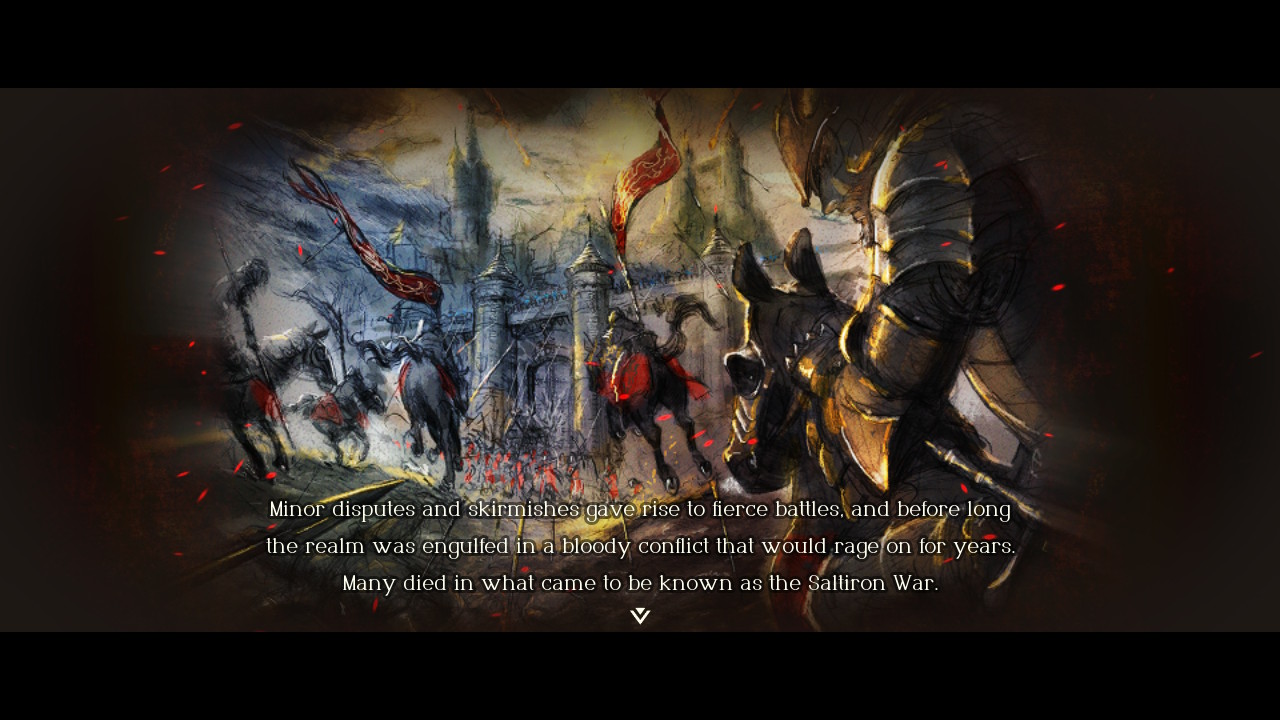
Thirty years prior to the game, Aesfrost and Hyzante went to war over the trade and supply of their two precious resources. This war was creatively dubbed “The Saltiron War”. However thanks to the mediation of Glenbrook, the region was able to create a tenuous peace which exists to this day.
Things are looking up for the prosperity of the realm, and the young Serenoa has been betrothed to the half-sister of Aesfrost’s archduke in hopes of solidifying their alliance. But as you learn early on, this bond is only so strong.
It’s Serenoa’s father himself that explains that if the two countries truly wanted a strong bond, why wed a bannerman’s son with the half-sister of the Archduke, born from a concubine no less?
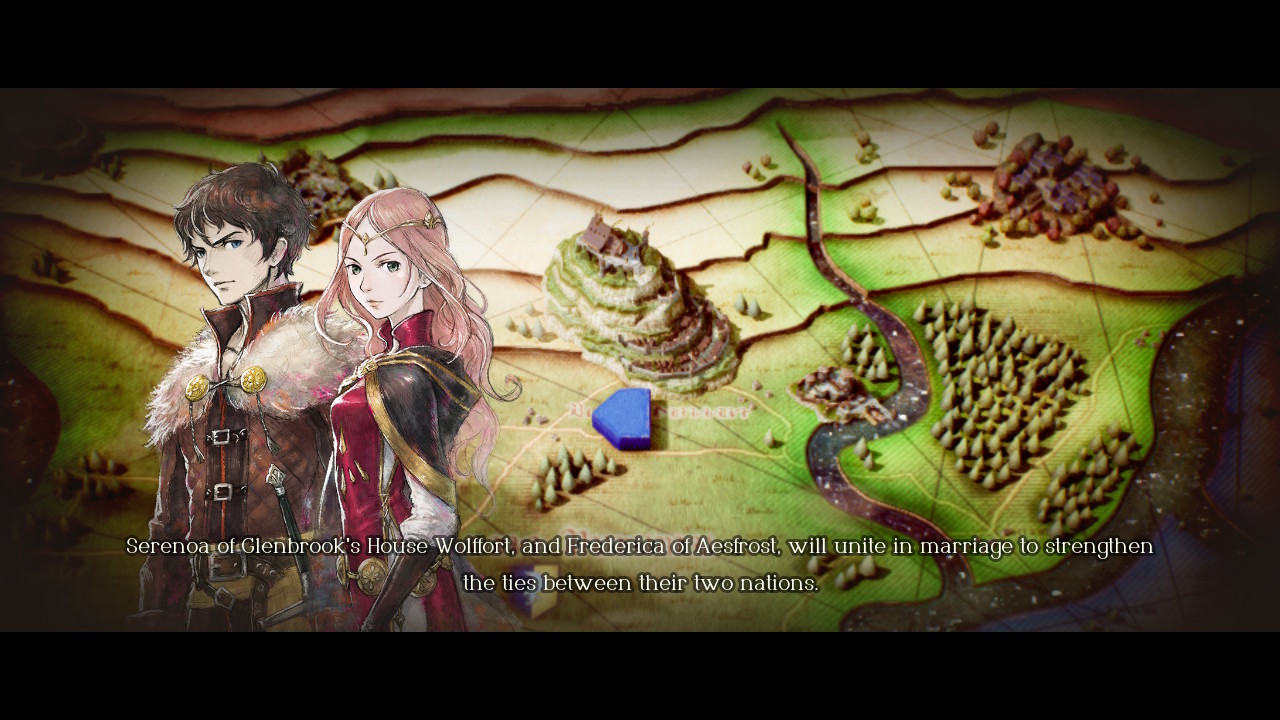
It’s with this escalation in tone that the game tries to instill hope that you’re in for a gritty medieval narrative; and thankfully Triangle Strategy delivers on this front. Yeah it’s a little goofy to call the region’s greatest conflict the Saltiron War, and yeah you’re introduced to an oppressed ethnic group because they have pink hair (this gets explained later, honest).
But that’s the thing: you’re thrust into a world of low science and arguably low education, you’re a young lord grappling with the realities, prejudices, and myths of Norzelia while trying to wrest a peaceful future from them. Forthrightness in storytelling is worth its weight in gold.
The cost for this forthrightness is a mountain of exposition. Optional notes to find and read, optional side cutscenes, and not to mention you’ve got roughly 3-10 cutscenes between every battle.
Triangle Strategy does not shy about shoving exposition down your throat, and it has to if it wants players invested in the game’s characters. Because unfortunately, the game’s mechanics will not make you invested.
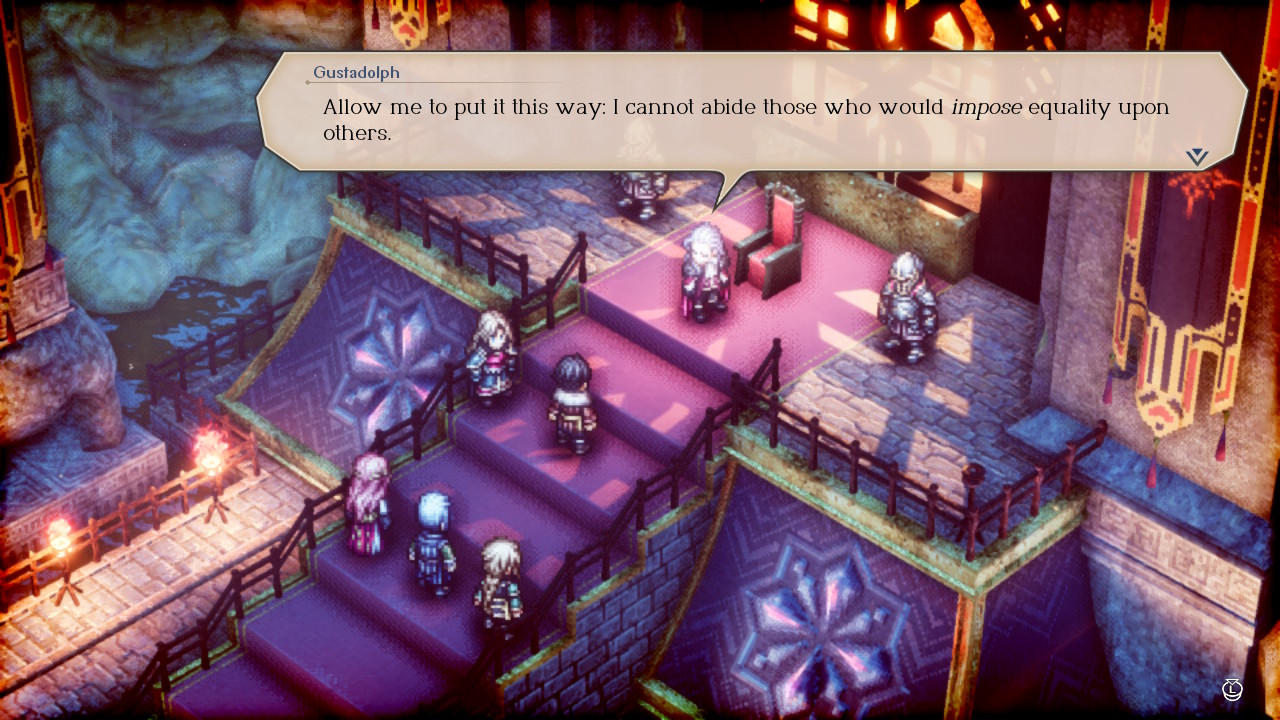
Fire Emblem and Final Fantasy Tactics have engaging stories, but they also have customizable units. In Fire Emblem: Three Houses you can turn your entire army into Dark Knights if it suits you, while in Final Fantasy Tactics you can make Ramza a Time Mage for fun.
Triangle Strategy has a job advancement system, but it’s strictly linear; Serenoa starts as a Swordsman, but with enough levels and a Medal of Bravery he can become anything from a wide variety of classes such as Swordfighter, Swordfighter, or even Swordfighter! Oh wait, that’s just one class, so yeah if you wanted to customize or build your own army, you’re out of luck here.
Triangle Strategy does offer an ironically linear gameplay experience given its marketing as a game where choices matter; but it can be rewarding to utilize your units innate strengths and weaknesses and command them as an elite strike squad.
So while I’m critical of the lack of customization in Triangle Strategy, it needn’t necessarily be a bad thing; in this instance I’m perhaps corrupted by my preconceived notions set by this game’s predecessors.
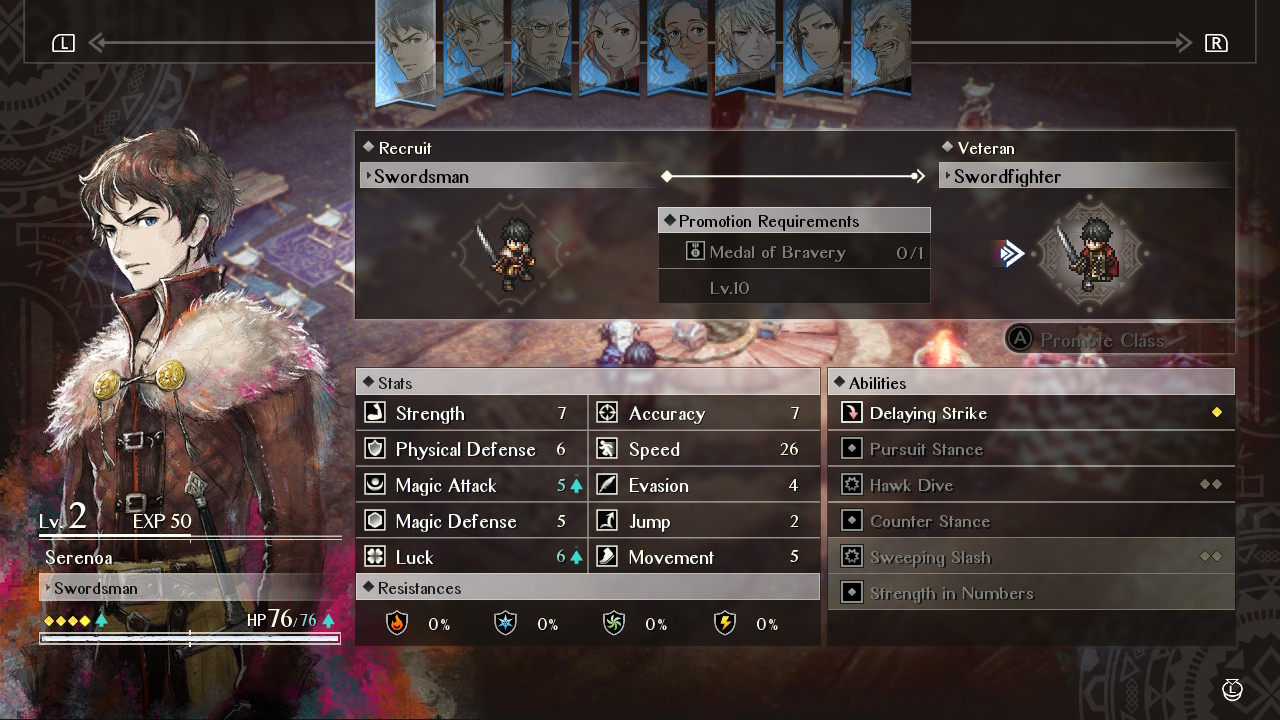
But lets get back to “choices matter”, a popular selling point which can be handled as well as Alpha Protocol to as poorly as Mass Effect 3. Interestingly, Triangle Strategy doesn’t let you make your own choices without first indulging the game’s narrative.
Key decisions are made by vote within your party and you’ll need to convince them to side your way depending on what you wish to do. These persuasions can be made easier by talking to NPCs and discovering tidbits of lore your followers might be interested in relating to the choice at hand.
Smaller choices can be made unilaterally and alter Serenoa’s “Convictions”. Convictions come in three flavors (this game is obsessed with the motif of three by the way): Morality, Liberty, and Utility.
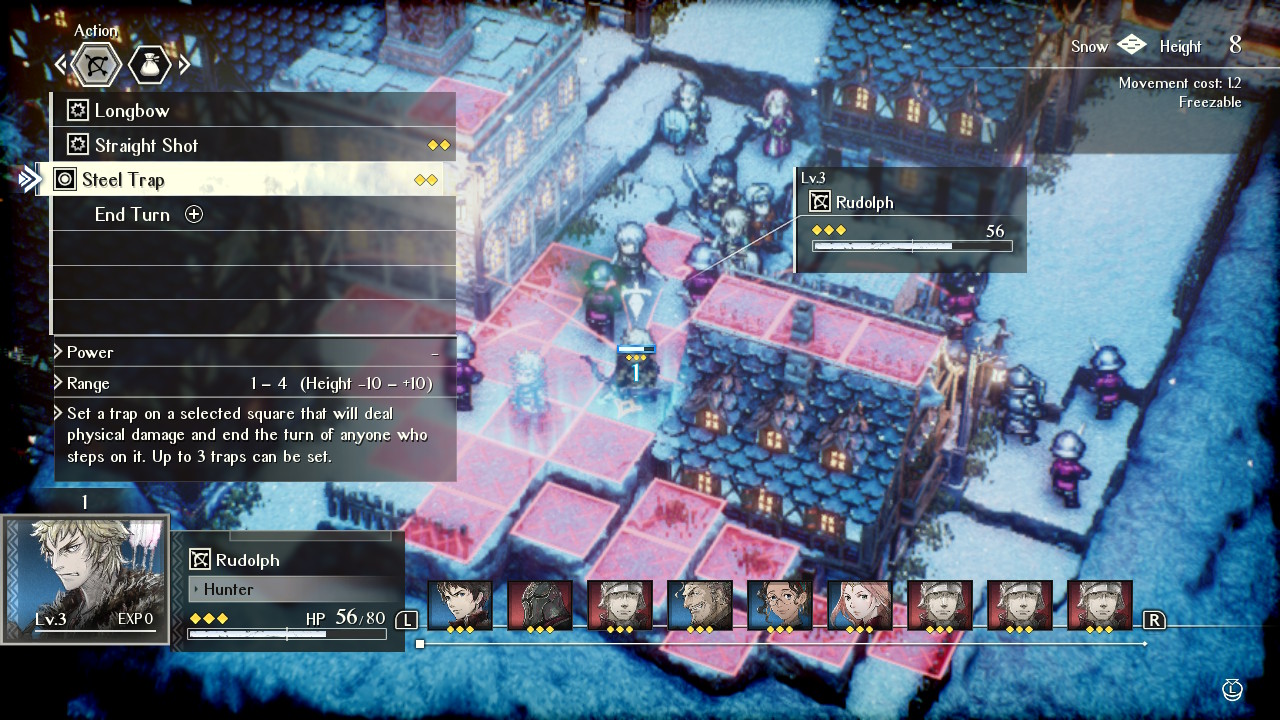
Increasing these invisible values will make Serenoa more persuasive and affect his ability to leave an impression on NPCs. Both the large choices you make with your party, and the small choices that define your Convictions can affect dialogue options and even what NPCs will join your party.
As for the game’s replayability given the climactic choice-making in the game, you’ll be pleased to know that Triangle Strategy has a convenient skip function which speeds up almost every interaction just by holding “R”. So once you’ve already seen a scene, just press the button and watch everything fast forward until you make a different choice.
So ultimately putting all these things together, where does that leave Triangle Strategy? It’s Fire Emblem without waifu collecting. It’s Disgaea without unit customization.
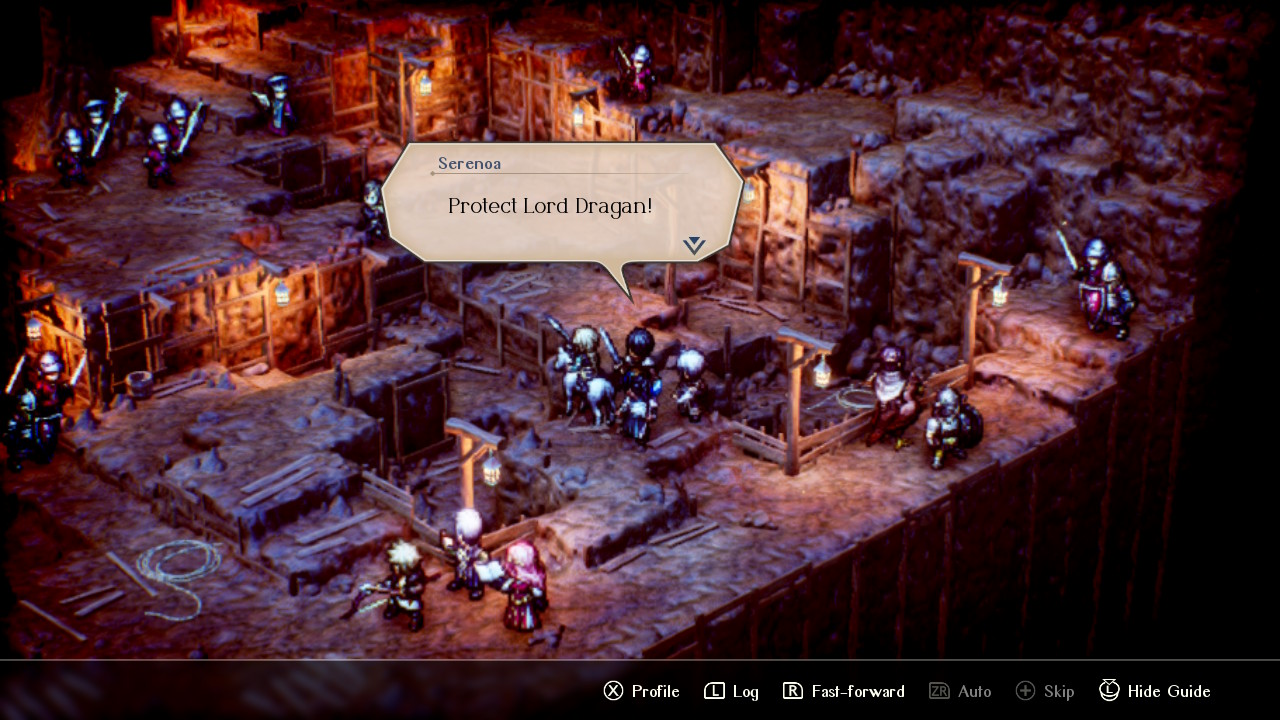
Ultimately, Triangle Strategy is a strong narrative RPG with an identity all its own. Triangle Strategy is a worthy successor to Final Fantasy Tactics, but if you’re like me you’ll have to learn to remove that expectation and let the game have its own identity.
I may seem ambivalent about the game throughout our Triangle Strategy review and each component of the game, but that’s only to give a thorough picture of what to expect.
Triangle Strategy is a return to form for single player games. There’s no multiplayer gimmick, there’s no DLC costumes; there’s just you, Serenoa, and the choices you make together. What more could you ask for?
Triangle Strategy was reviewed on Nintendo Switch using a copy provided by Nintendo. You can find additional information about Niche Gamer’s review/ethics policy here. Triangle Strategy is now available for Nintendo Switch (via the eShop).